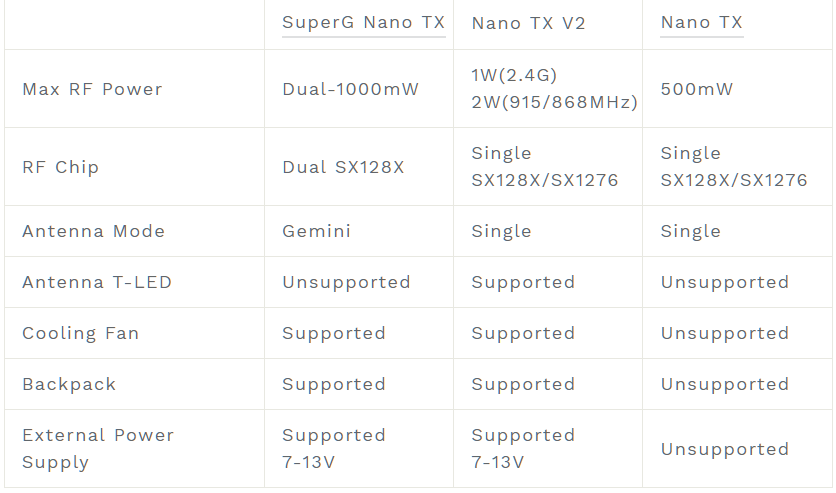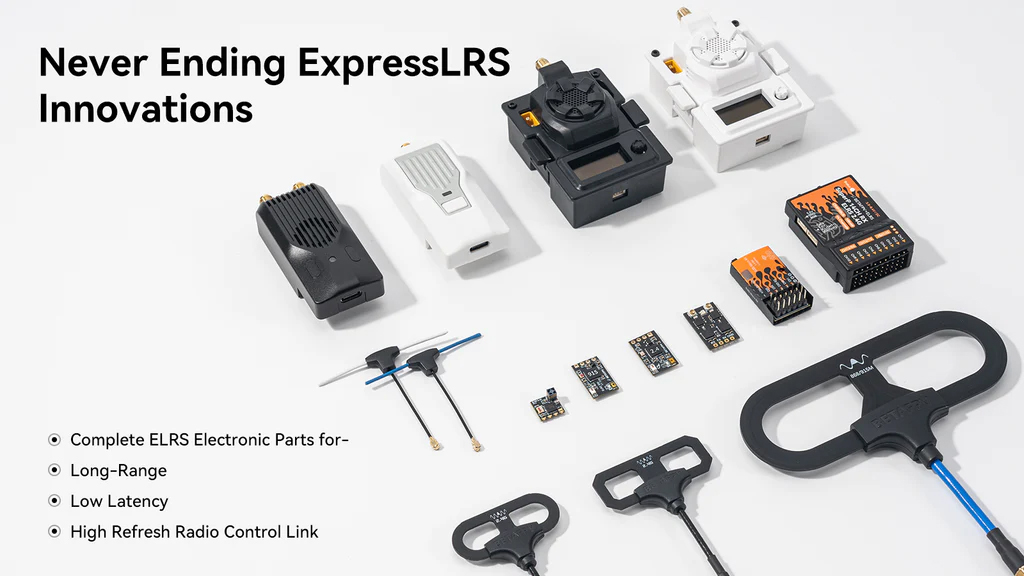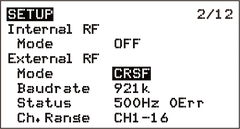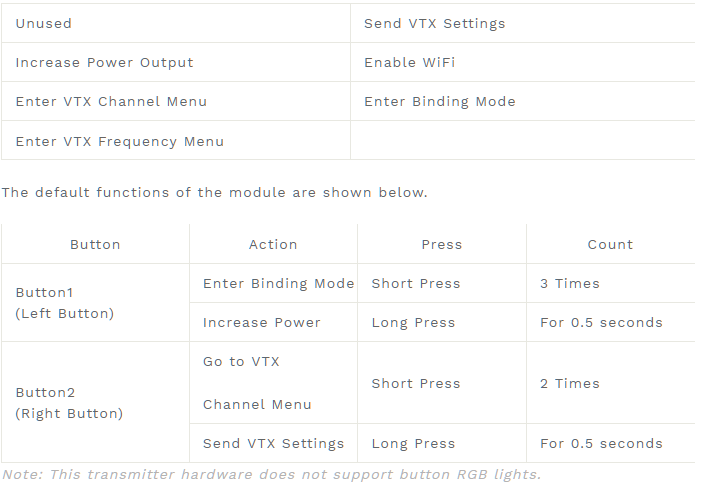Copy and share this link on social network or send it to your friends
Copy| Product Name | (BETAFPV)Nano TX V2 Module ELRS 2.4GHz/ELRS 915MHz/ELRS 868MHz For Aircraft Toy Accessories |
| Item NO. | F51891-D1 D2 D3 |
| Weight | 0.14 kg = 0.3086 lb = 4.9384 oz |
| Category | DIY RC Drone Accessories |
| Brand | BETAFPV |
| Creation Time | 2024-03-08 |
(BETAFPV)Nano TX V2 Module ELRS 2.4GHz/ELRS 915MHz/ELRS 868MHz For Aircraft Toy Accessories
The Nano TX V2 Module is packed with upgrades for an unrivaled pilot experience. Featuring the innovative T-LED antenna with its flicker frequency
indicating signal transmitting and module connection statute. With up to 1W/2W power, it empowers stable links for FPV racing, long-range flight, and
professional photography. Seamlessly integrate with Backpack and customize buttons. Enjoy fluently flying with the 1804 cooling fan. Unleash your full
potential with the Nano TX V2 Module.
Nano TX V2 Module
Nano TX V2 Module
Bullet Point:
The First ever T-LED antenna with built-in LED display functionality, allowing pilots to effortlessly monitor the signal transmitting and receiving while
using the radio transmitter.
It offers 3 versions: 2.4GHz with a maximum output power of 1W, and 915/868MHz with a maximum output power of 2W. The max packet rate is F1000/200Hz.
Featuring an integrated TCXO, it minimizes frequency deviation for stable performance, eliminating signal interference.
With its optimized internal airflow channel and a heat sink, a high-speed 1804 cooling fan, it effectively dissipates heat even during high power output,
ensuring stable link performance.
Support backpack and custom button functions based on ELRS V3.3, empowering pilots to connect external devices and set buttons according to personal
usage habits.
Specification:
Item: BETAFPV Nano TX V2 Module | ELRS 2.4GHz/915MHz/868MHz
Weight: 28g
Color: White
Antenna Connector: RP-SMA(2.4GHz), SMA(915/868MHz)
RF Power(2.4GHz): 25mW/50mW/100mW/250mW/500mW/1000mW
RF Power(915/868MHz): 10mW/25mW/50mW/100mW/250mW/500mW/1000mW/2000mW
Packet Rate(2.4GHz): 50Hz/100Hz/150Hz/250Hz/333Hz/500Hz/D250/D500/F500/F1000
Packet Rate(915/868MHz): 25Hz/50Hz/100Hz/100Hz Full/200Hz/D50
Frequency Band: 2.4GHz ISM, 915MHz FCC, 868MHz EU
Backpack: Support
Input Voltage: 7V~13V DC
Power Consumption(2.4GHz): 8V,1000mA@1000mW, 150Hz,1:128
Power Consumption(915/868MHz): 8V,1000mA@1000mW, 50Hz,1:128
USB Port: Type-C
Fan Voltage: 5V
Default Firmware Version: ExpressLRS V3.3.0
Diagram
Below is the diagram for the Nano TX V2 Module.
Nano TX V2 Module
Note: Please assemble the antenna before powering on. Otherwise, the PA chip in the Nano TX V2 Module will be damaged permanently.
The following is the comparison information. It shows the advancing updates and specifications.

1W&2W Output Power
The Nano TX V2 Module also offers 3 versions: 2.4 GHz with a maximum output power of 1W, and 915/868MHz with a maximum output power of 2W. Featuring an
integrated TCXO, it minimizes frequency deviation for stable performance, eliminating signal interference. Experience stronger signals, longer transmission
distances, and an expanded radio transmitter range. With these options, pilots can explore and connect with greater freedom in wireless communication.
Nano TX V2 Module
Longer Range with Stable Link Quality
Nano TX V2 Module is built-in a TCXO (temperature-compensated crystal oscillator). With the high-quality TCXO, it can withstand extreme temperatures with no
fear of heat and cold, continuously outputting accurate frequency for long-range flight. Click to learn more about the TCXO. ensuring a super stable yet
strong radio link for pilots to fly in any environment that requires extremely stable signals and low latency, including long-range flights, multiplayer
flights, and FPV racing. It gives pilots a robust and aggressive flight experience.
Nano TX V2 Module
T-LED Antenna
The T-LED antenna innovatively integrates LED with the antenna, enabling direct information display on the antenna. When the antenna is successfully
connected, the regular flickering indicates the status of signal transmission and reception. The light being on represents signal transmission, while the
light being off represents signal reception. The speed of the flickering varies based on the telemetry ratio and packet rate, offering pilots a unique
visual experience.
Additionally, it detects the connection status between the antenna and the TX module, preventing damage caused by incorrect usage. The flickering light
irregularly during the antenna swinging indicates antenna damage, while flickering irregularly during turning the antenna connector indicates a loose
connection in either the antenna or the TX module, requiring replacement.
Note: This T-LED Antenna only lights up on the Nano TX V2 Module. Other antennas like Moxon and Loop can also be used directly on the Nano TX V2 Module
(915/868MHz version), but the 2.4GHz version requires an RP-SMA to SMA adapter.
Cooling System
The Nano TX V2 features a fully injection-molded shell with excellent texture. With its optimized internal airflow channel and a heat sink, a high-speed
1804 cooling fan, it effectively dissipates heat even during high power output, ensuring stable link performance. Pilots can fly with confidence and enjoy
reliable performance, thanks to this double-checked cooling solution.
Nano TX V2 Module
Highly Customizable Solution
Backpack, developed by the ExpressLRS team, is an optional module designed for radio transmitters. It provides enhanced flexibility and scalability,
empowering pilots to connect external devices such as goggles, the Nano TX V2 Module offers a highly customizable and expandable solution for pilots'
varied application scenarios and functional needs. There are two buttons reserved for pilots to customize their functions, empowering pilots to set buttons
according to personal usage habits.
Combination with Most Radio TX
The Nano TX V2 Module could be configured via LUA script. EdgeTX V2.8.0 and OpenTX radio transmitter that supports CRSF could be used easily. It is available
for popular Nano port TX like BETAFPV LiteRadio 3 Pro, Radiomaster Zorro/Pocket, Jumper T Pro V2/T20, TBS Tango 2, etc., and Radiomaster TX16, Boxer, and
Jumper T16/T20, Frsky QX7, X9 when used with a Micro-Nano Module Adapter.
ELRS Series
The ExpressLRS Series expands its lineup with the addition of the Nano TX V2 Module. To achieve exceptional link quality. BETAFPV takes the flying experience
to new heights by introducing ELRS links that offer long-range capabilities, low latency, and high refresh rates in a radio control system.

Basic Configuration
In the EdgeTX system, select "MODEL SEL" and enter the "SETUP" interface. In this interface, turn off Internal RF (set to "OFF"), turn on External RF, and
set the output mode to CRSF. Connect the module correctly and then the module will function properly. Settings are shown below.

Lua is a lightweight and compact script language. It can be used by being embedded in radio transmitters and easily reading and modifying the parameter set
of modules. The directions for using Lua are as below.
Download the elrsV3.lua on the BETAFPV official website or ExpressLRS configurator
Save the elrsV3.lua files onto the radio transmitter's SD Card in the Scripts/Tools folder
Press the "SYS" button or the "Menu" button on the EdgeTX system to access the "Tools" interface where you can choose "ExpressLRS" and run it
The below images show the Lua script if it runs successfully
Custom Buttons
There are two buttons reserved for users to customize its functions. Operation steps are shown below.
Enter the WiFi mode by enabling the module or powering it on for 60 seconds
Once the RGB state indicator is in slow green flashing, the receiver's WiFi will be activated (WiFi name: ExpressLRS TX, password: expresslrs
Connect your phone or computer to WiFi, and log in to the browser at http://10.0.0.1. You will be able to find the custom button settings page
In the "Action" column, select the desired custom Function; In the "Press" and "Count" columns, select the button press type and the number of presses
or duration of the press
Click "Save" to complete the configuration
There are six settable shortcut buttons and two ways to use the buttons: long press and short press. The long press can be set to a custom time duration,
while the short press can be set to a custom number of presses. Six settable functions are shown below.

Bind & External Power Supply
The default firmware of the Nano TX
V2 module is ExpressLRS version 3.3.0. There is no Binding Phrase
pre-set. Hence Binding with transmitters has to
ensure that the receiver is using V3.0.0 above with no binding phrase.
Put the receiver into binding mode and wait for the connection.
Quick press button 1(Left button) three times to enter the binding
mode(factory default setting), or you can enter binding mode by clicking
'Bind' in
the Lua script. if the Indicator has turned solid, it indicates that the device has been bound successfully.

The power consumption of the Nano TX V2 module when using a transmission power of 500mW or above is relatively high, which will shorten the usage time of
the remote control. Users can provide power to the module by using an XT30-USB adapter cable to connect to an external battery. The usage method is shown
in the following figure.
The power consumption of the transmitter is not only related to the transmit power but also to the telemetry ratio. When using high power of 500mW and
above, the return ratio can be set higher to reduce power consumption and extend use time.
For example, in Gemini mode, the power consumption of setting the return ratio to 1:128 is 1000mA, while the power consumption of setting the return
ratio to 1:2 is only half of 1:128.

FAQ
1. Unable to enter LUA script, possible reasons are as follows:
The TX module is not well connected to the remote control, need to check whether the Nano pin of the remote control and the TX module socket are in good
contact
The version of the ELRS LUA script is too low and needs to be upgraded to elrsV3.lua
If the baud rate of the remote control is too low, set it to 400K or above (if there is no option to set the baud rate of the remote control, you need
to upgrade the firmware of the remote control, e.g., the EdgeTX needs to be V2.8.0 or above)
Target Name: BETAFPV Nano V2 2.4GHz/915MHz/868MHz TX
2. Packet Rate cannot be set to F1000 or prompt "Baud rate is too low".
Reason: The problem is caused by the baud rate of the remote control is too low because the F1000 packet rate needs above 400K baud rate support to work
Solution: You first need to update the baud rate (greater than 400K is fine) setting in the Model Setup menu or System menu->Hardware, and then reboot
the remote control to make sure the baud rate setting has been applied

3. The packets between the remote control and the TX module are less than 1000, while the F1000 packet rate is turned on.
Reason: This issue is caused by synchronization issues with the remote control system EdgeTX
Solution: Upgrade the EdgeTX version of the remote control to 2.8.0 or above
Package
1 * Nano TX V2 Module
1 * T-LED Antenna
1 * USB to Type-C Data Cable
1 * Type-C Male to XT30U Male Power Cable
1 * Instruction Manual
1 * Service Card
SKYPE: +8615012643826
Email:yxy@xt-xinte.com
No related record found